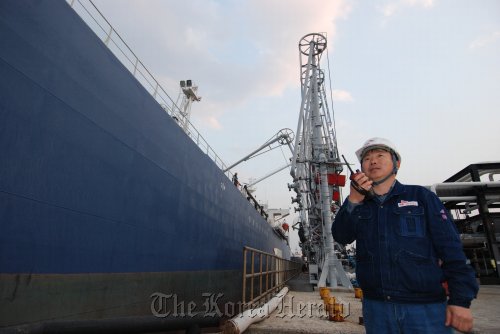SK Group, which runs local top refinery SK Innovation, jumpstarted growth into one of the country’s top chaebol 20 years ago when it vertically integrated its petrochemical operations.
In 1991, the family-run conglomerate established nine facilities to produce refined oil, petrochemicals, film and textile at its complex in Ulsan, a southeastern port in Korea, seeking to become a leader in the local market for products ranging from petroleum to fibers.
Shortly after taking office in 1998, chairman Chey Tae-won went further by launching an export drive, for which he orchestrated projects between the group’s chemical, energy, gas and trading arms. He also multiplied investment in renewable energy, petrochemical facilities and resources development in Indonesia, Vietnam, Peru and others.
“Chairman Chey is steering vertical integration of all energy units including natural gas, green energy and alternative energy based on the practice implemented 20 years ago,” said Lee Man-won, senior vice president of SK Brand Management Department.
Sales rose tenfold over the two decades to top 100 trillion won ($93 billion) last year. SK expects the number to reach 110 trillion won this year.
SK’s petrochemical exports expanded to more than 21 trillion won in 2005 and 27 trillion won last year from a mere 1 trillion won in 1991.
It is currently active in 26 mining blocks in 14 countries, securing 530 million barrels of crude oil, sufficient to supply the Korean population for about eight months.
In the electronics industry, Samsung has preserved vertical integration as its key strategy. It makes displays, chips, mobile phone batteries for all of its hardware, while selling related components to other manufacturers.
Early this month, Korea’s top conglomerate was ranked No. 10 in the world’s top 25 supply chains list by Gartner Inc., which U.S. electronics giant Apple Inc. topped.
Analysts at the global market research firm said vertically integrated Samsung has been “weathering the ups and downs through ownership of supply.”
They also note that companies such as PepsiCo Inc. and The Coca-Cola Company ― No. 9 and No. 11 respectively ― are becoming more vertically integrated by acquiring their largest bottlers, while Microsoft and Cisco are dealing with an extensively outsourced network of trading partners.
“The key isn’t whether a company owns all the pieces of its network ― it’s how well it controls the outcome of the activities that take place in the network that end in the delivery of a final product to a customer,” said Debra Hofman, research vice president at Gartner.
STX Group, which was founded from the remnants of Ssangyong Heavy Industries, also has a vertically integrated structure centered on its main business ― shipbuilding.
Starting off with STX Corp. by acquiring Ssangyong Heavy in 2001, the group quickly added subsidiaries producing engines, and parts for engines and ships.
In 2004, a shipping firm was added to the group, completing the process of vertical integration of STX’s business portfolio that goes from ship-parts making to shipbuilding and to shipping.
While SK and STX groups sought to increase productivity through vertical integration, the country’s second largest conglomerate Hyundai Motor Group is aiming for the same results through what it calls “resource circulating business structure.”
In April last year, the group’s steelmaker Hyundai Steel opened its integrated steelworks in Dangjin, South Chungcheong Province.
The completion of the integrated steelworks, which is said to have been one of the handful of unfulfilled dreams that late Hyundai Group founder Chung Ju-young, was much touted as a significant step forward for the group by its leaders including chairman Chung Mong-koo.
“With the completion of the plant, Hyundai Motor Group is able to complete the world’s first ‘resource circulating business structure’ that goes from molten iron to automobiles,” Chung said at the time of the plant’s opening.
The project, which took nearly four years to complete and more than 6 trillion won ($5.6 billion) in investment, made Hyundai Steel the country’s second steelmaker to operate blast furnaces.
Until January last year, when the first of the facility’s two blast furnaces were fired up, the company had operated only electric arc furnaces that use scrap steel instead of coal and iron ore to produce crude steel.
However, more than simply improving Hyundai Steel’s position in the steel industry, the plants completed Hyundai Motor Group’s “resource circulating structure.”
According to industry analysts, operating blast furnaces offers an up to 20 percent profit margin, while margins offered by electric arc furnaces ranges from 5 percent to 10 percent.
Under the resource circulating business structure, steel produced at the Dangjin plant will be processed by Hyundai Hysco into cold-rolled products, which will then be used in Hyundai Motor Co. and Kia Motors Corp.’s vehicles.
The steel from scrapped vehicles will then be melted down at Hyundai Steel’s electric blast furnace and used to produce construction materials, which will be used by the group’s construction firms.
By Choi He-suk and Shin Hyon-hee
(
cheesuk@heraldcorp.com) (
heeshin@heraldcorp.com)








